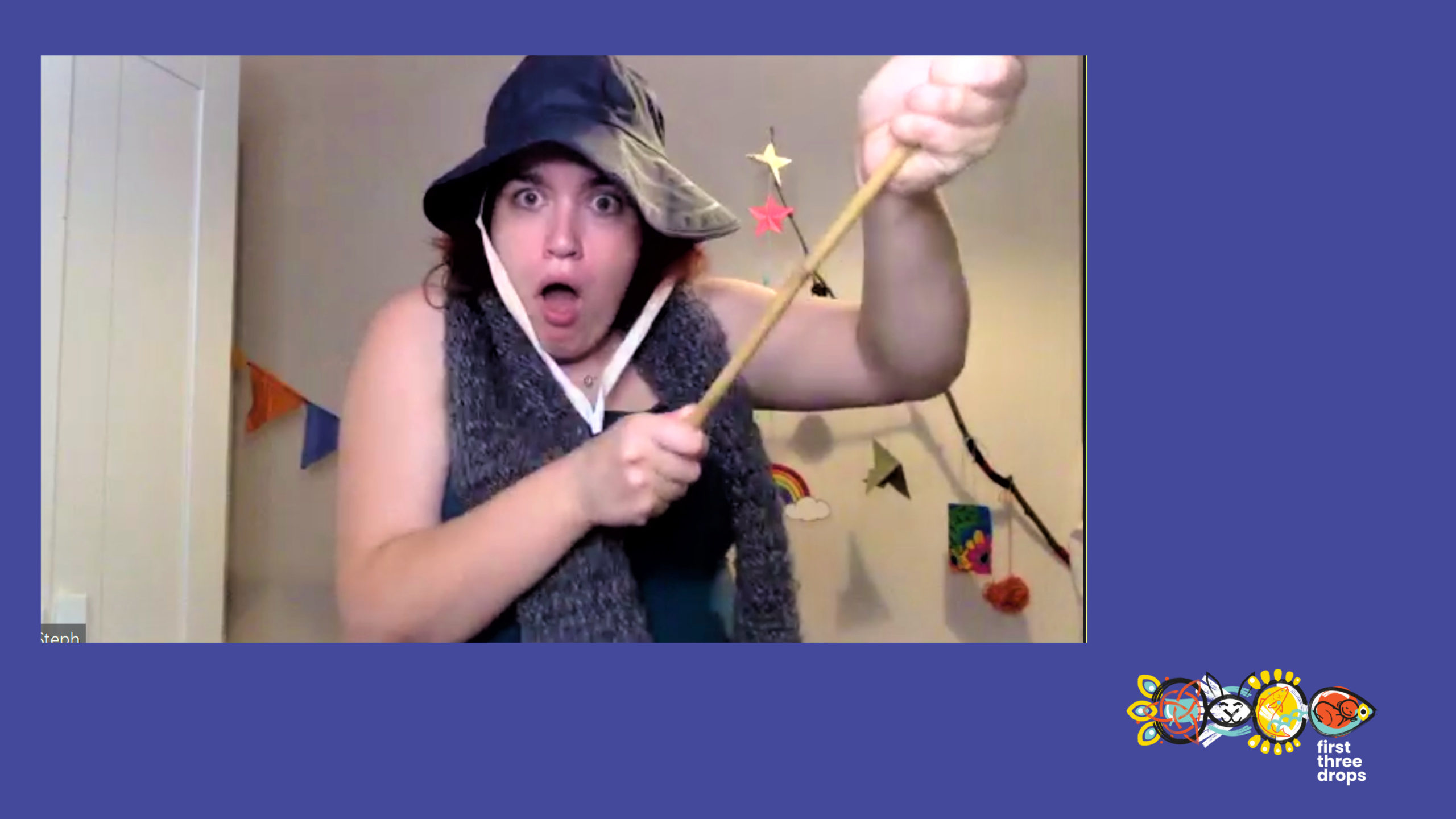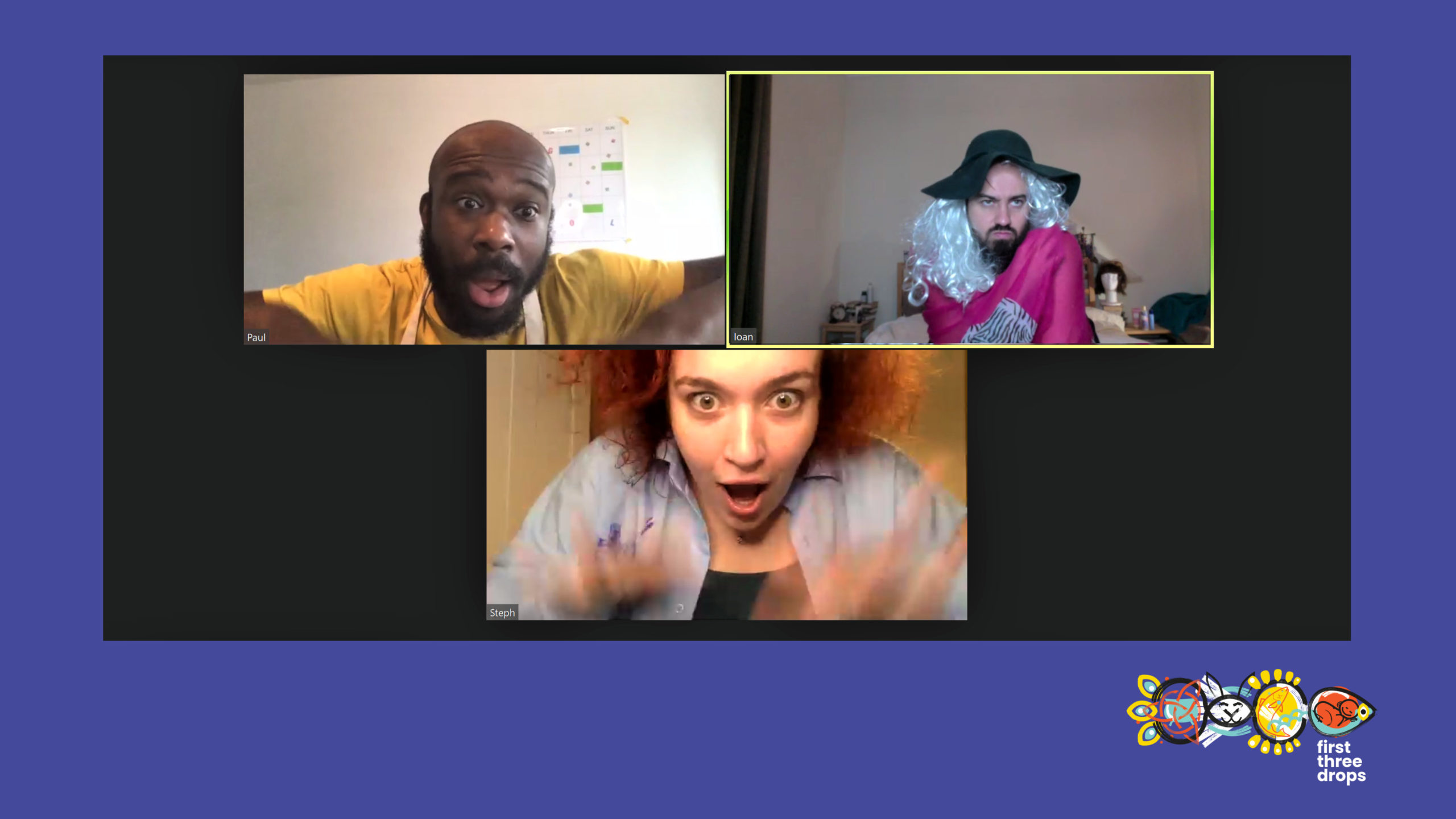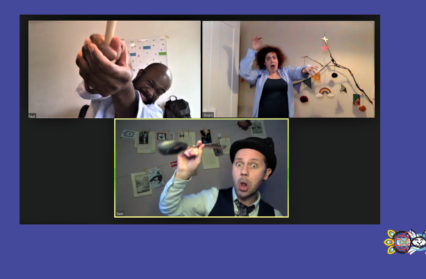Phil Morris reviews First Three Drops, an energetic family play by Elise Davison based on the legend of Taliesin. Performed over Zoom in English, British Sign Language and Sign Supported English, the play is an inclusive and imaginative adventure.
The narrator of Taking Flight’s Zoom play for families First Three Drops, played by Sam Bees, opens the show with an admission that he may lack the necessary words to tell the legendary story of Taliesin. In doing so, he speaks to children’s anxieties about being able to adequately express themselves through language, and to theatre-makers’ current doubts about the relevance and future viability of their work. Happily, over forty-five minutes of inspired silliness – replete with a “beautiful, powerful, fabulous” sorceress, a manic chicken, a cauldron filled with magic potion, and an oversized baby enthusiastically filling up his extremely smelly nappy – this small but perfectly-formed company overcomes the limitations of a tiny budget, and the demands of performing in split-screen and in close-up, to create a joyous entertainment that enlarges the focus of Zoom beyond the talking head.

First Three Drops by Elise Davison is the origins story of mythical Welsh bard Taliesin, who starts out as a humble boy-servant named Gwion. The aforementioned “beautiful, powerful, fabulous” sorceress Ceridwen, tasks Gwion with stirring her white witch’s brew for a year and a day, warning him not to drink any as its first three drops will enable him to know “everything there is to know”. Gwion accidentally spills three drops on his thumb, which he consumes upon suckling his burn, and suddenly he is aware of a vast range of facts including; “Vincent van Gogh painted Starry Night” and “the mouth of a starfish is also it’s bum”. Endowed with such capacious knowledge, the errant Gwion is able to magically transform himself into various animals, which Taking Flight takes great delight in depicting, and thereby elude the wrathful Ceridwen who gives chase.
A cast of four sustains a high level of energy throughout the play, which is typical of theatre for young people, though the vividness of the acting in this case is somewhat enhanced by the use of British Sign Language (BSL) and Sign Supported English. Each actor communicates on both a gestural and oral level, so that the screen captures performances that are, by definition, as physical as much as spoken. The production is therefore accessible to non-hearing audiences, while offering those able to hear the intriguing prospect of watching actors parallel the signed word with the spoken word. The Zoom broadcast also facilitates Closed Captioning and Audio Descriptions, widening the range of accessibility to audiences and foregrounding a multiplicity of communicative modes through which the story is told.

This variety of language and approach, (the text also incorporates a number of Welsh words and phrases), is what distinguishes First Three Drops as a family show worthy of particular note. Writer Elise Davison’s direction is zippy and sure-footed, circumventing the separation of her cast into the corners of a computer screen with simple yet effective devices; a prop is tossed out of shot by one character placed in the top-right section and it falls into the hands of another placed bottom-left, the pungent smell of a baby’s full nappy wafts up from the lower half of the screen to appal two characters in its top half. Such playfulness reveals the rich potential for the Zoom platform to deliver engaging and interactive live theatre for children, especially in this age of COVID-19. Theatre for young people and children’s television often deploy direct address to the audience or camera as a means of establishing a strong rapport between performer and audience, and so the aesthetic of Zoom works to the advantage of actors in a digitally presented family show. Theatre pieces produced on Zoom for adults would appear to require a conceit to explain just why an actor is talking directly to camera; whereas children are more familiar with actors breaking the fourth wall and drawing attention to the constructed-ness of their story-making, so that the screen is not so much of an impediment to engagement.
Taking Flight is clearly experienced in engaging with children; cast members Sam Bees and Steph Black are particularly good at projecting a sense of fun and mischief through the Zoom lens. More impressively, the entire cast is able to relate to each other effectively across the split-screen format, so that a strong sense of ensemble is forged even though the actors occupy four sections of a two-dimensional screen rather than a single physical performance space.
It would be interesting to see, with additional research and development funding in place, how Taking Flight might further explore the interactive possibilities of accessible theatre for young people via Zoom. Free support packs, including designs for making masks and origami sculptures, were made available to those attending the show, and there is possibly greater scope for children to participate more interactively in future iterations of the First Three Drops, perhaps electing to appear on screen at certain moments to display their creations.
Following on from their thought-provoking and sophisticated staging of Kaite O’Reilly’s Peeling (2019), Taking Flight have shown once again that inclusive theatre on a limited budget can be bold, innovative and intelligent. After many, seemingly endless months of lockdown, government-issued guidelines and generalised low-level anxiety, it was a real tonic for this reviewer to discover a show that in its accessibility, multi-lingual interplay and digitised goofiness seemed to open up a world of possibilities.
For more information on Taking Flight’s productions and Elise Davison’s work, visit their website here.
You might also like…
Georgia Winstone reviews Hijinx’s COVID-inspired adaptation of Franz Kafka’s Metamorphosis.
Phil Morris is a regular contributor to Wales Arts Review.












